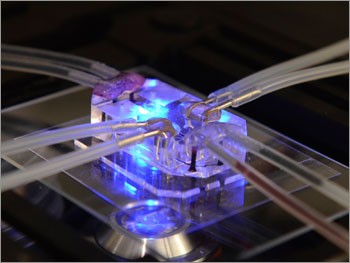This year's winner for the Design Museum Design of the Year Award is all about function meets design where this unique microchip holds an immense wealth of scientific surprises. In about eight years, this is the first time that a medical design won the Design Museum award.
This remarkable, glowing box is actually a smart container for living human tissue which is apparently capable of mimicking several human organs. This include the heart, lungs, bone marrow, liver and kidneys which are all simulated and replicated in a small, glowing microchip that could be the answer to the end of animal testing.
The chip is roughly the size of a tiny USB where it is lined with living, breathing human cells that can create an imitation of the various functions and micro architecture of human organs.
Scientists and researchers from the Harvard University's Wyss Institute for Biologically Inspired Engineering namely Donald Ingber and Don Dongeun Huh designed and conceptualized this microchip in order to develop 10 similar microchips that are all designed to mimic the entire human body.
Apart from saving animal lives from testing trials, these chips can become a precursor to unlimited safe testing in the field of medicine.
This could mean that personalized medicine will now become easier to develop where this microchip can help to test the effects of certain drugs by replicating an individual's organ/s. This would also mean that developing new drugs can become easier and faster since testing live subjects is now obsolete, replaced by these microchips.
According to director for the Design Museum Deyan Sudjic, this team of scientists have created a remarkable object where they did not originate from a design background, yet successfully executed a brilliant piece of design. The team approached their innovation with elegance and economic sensibilities that merges technology to work with new ways.



























